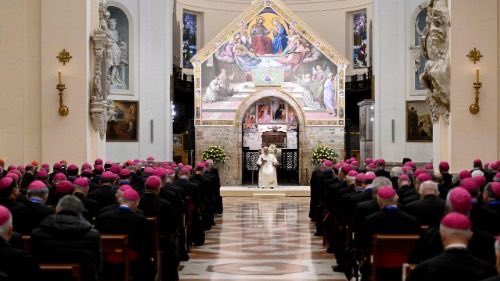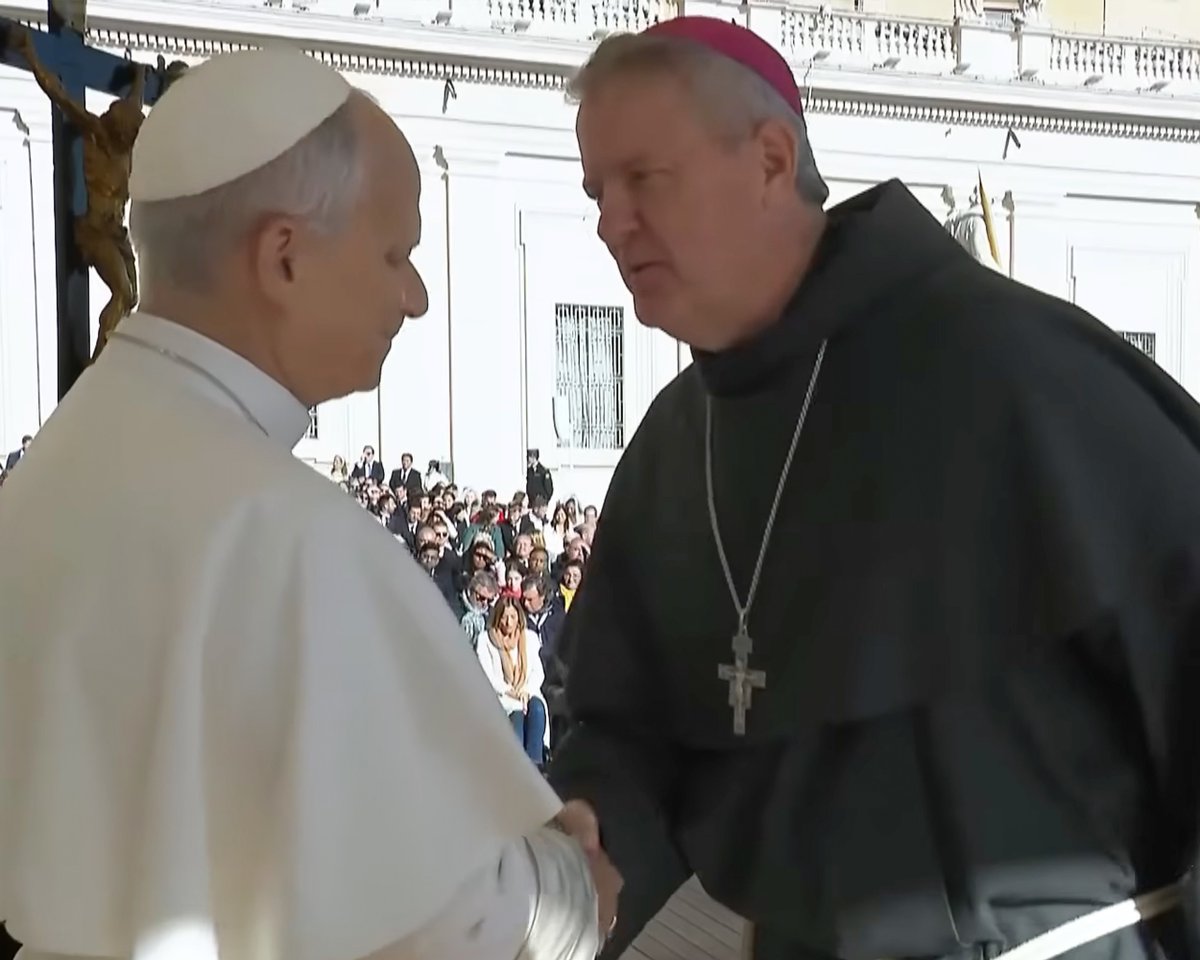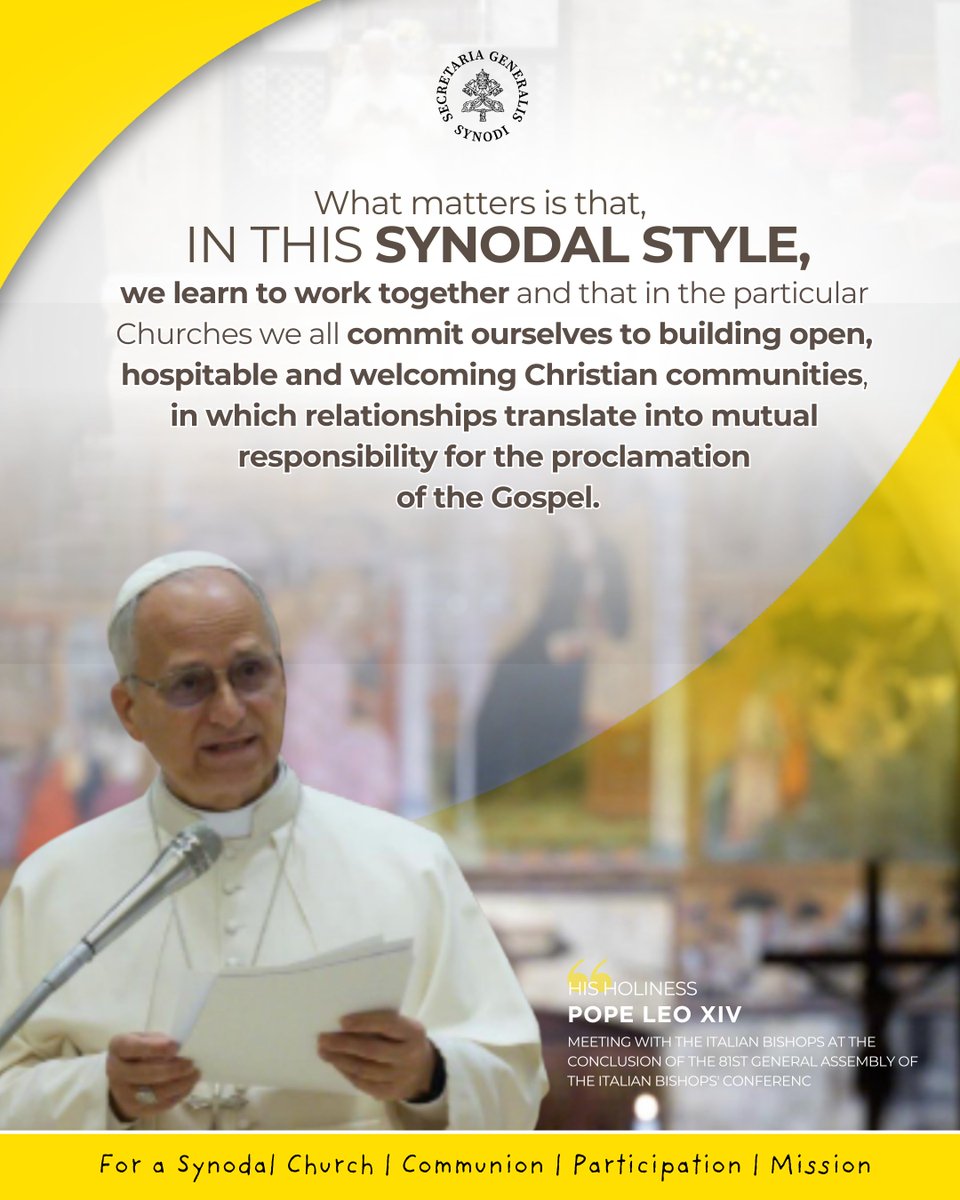One false prophet recommends another…
Francis endorses Teilhard de Chardin’s ‘Mass on the World’
 His true god was evolution: the French Fr. Pierre Teilhard de Chardin, S.J.
His true god was evolution: the French Fr. Pierre Teilhard de Chardin, S.J.
On his recent blather tour in Mongolia (Aug. 31 – Sep. 4, 2023), the Argentinian apostate Jorge Bergoglio (‘Pope Francis’) offered some impromptu remarks after presiding over the Novus Ordo worship service (incorrectly termed ‘Holy Mass’) in the capital of Ulaanbaatar on Sep. 3. He took the opportunity to speak favorably of the notorious French Jesuit Fr. Pierre Teilhard de Chardin (1881-1955) and his infamous ‘Mass on the World’, written in 1923:
The Mass is itself a way of giving thanks: “Eucharistía”. To celebrate Mass in this land brought to my mind the prayer that the Jesuit Father Pierre Teilhard de Chardin offered to God exactly a hundred years ago, in the desert of Ordos, not far from here. He prayed: “My God, I prostrate myself before your presence in the universe that has now become living flame: beneath the lineaments of all that I shall encounter this day, all that happens to me, all that I achieve, it is you I desire, you I await”. Father Teilhard de Chardin was engaged in geological research. He fervently desired to celebrate Holy Mass, but lacked bread and wine. So he composed his “Mass on the World”, expressing his oblation in these words: “Receive, O Lord, this all-embracing host, which your whole creation, moved by your magnetism, offers you at the dawn of this new day”. A similar prayer had already taken shape in him when he served as a stretcher-bearer on the front lines during the First World War. This priest, often misunderstood, had intuited that “the Eucharist is always in some way celebrated on the altar of the world” and is “the living centre of the universe, the overflowing core of love and of inexhaustible life” (Laudato Sì, 236), even in times like our own, marked by conflicts and wars. Let us pray this day, then, in the words of Father Teilhard de Chardin: “Radiant Word, blazing Power, you who mould the manifold so as to breathe life into it, I pray you, lay on us those your hands – powerful, considerate, omnipresent”.
(Source; underlining added.)
Obviously, the only Host intrinsically acceptable to be offered to Almighty God is Jesus Christ. Apart from that Sacrifice — offered once and for all on the Cross (see Heb 10:12-14; 1 Pet 3:18) and perpetuated mystically through time in the Holy Mass (see Lk 22:19) — any and all of our own personal sacrifices have no supernatural merit. It is only in dependence upon, and subordination to, the Sacrifice of Calvary that our works, our joys, our sufferings, our penances, our prayers have value before God.
To attempt to offer to God “the world” in place of the Divine Victim of Calvary would have to be a blasphemy of staggering proportions. It can perhaps be considered a kind of New Testament version of the sacrifice of Cain: “Woe unto them, for they have gone in the way of Cain: and after the error of Balaam they have for reward poured out themselves, and have perished in the contradiction of Core” (Jude 11). And now this blasphemous sacrifice enjoys the public approval of ‘Pope’ Francis.
However, it is not only ‘Pope’ Francis who is on record praising Teilhard — some of his predecessors of unhappy memory have likewise done so. For example, in 1995, Bp. Karol Wojtyla (‘Pope John Paul II’) wrote in a book: “The Eucharist is also celebrated in order to offer ‘on the altar of the whole earth the world’s work and suffering’, in the beautiful expression of Teilhard de Chardin” (Gift and Mystery [Rockland, MA: Wheeler Publishing, 1997], p. 58).
Fr. Joseph Ratzinger (‘Pope Benedict XVI’), too, is on record speaking well of Teilhard. At a homily in 2009, Benedict praised his “great vision” of a “cosmic liturgy”:
The role of the priesthood is to consecrate the world so that it may become a living host, a liturgy: so that the liturgy may not be something alongside the reality of the world, but that the world itself shall become a living host, a liturgy. This is also the great vision of Teilhard de Chardin: in the end we shall achieve a true cosmic liturgy, where the cosmos becomes a living host. And let us pray the Lord to help us become priests in this sense, to aid in the transformation of the world, in adoration of God, beginning with ourselves. That our lives may speak of God, that our lives may be a true liturgy, an announcement of God, a door through which the distant God may become the present God, and a true giving of ourselves to God.
(Antipope Benedict XVI, Homily at Vespers in Aosta, Italy, July 24, 2009; underlining added.)
In an official public address as ‘Pope emeritus’, on the occasion of the 65th anniversary of his ordination to the priesthood in 2016, Ratzinger even misappropriated the sacred term “transubstantiation” for this Teilhardian idea, claiming that Jesus Christ through His Cross “fundamentally transubstantiated life and the world” and that he, Benedict, wanted to “contribute to the ‘transubstantiation’ of the world so that it might not be a place of death, but of life…” (Address of June 28, 2016).
Thus it is clear that we can place Benedict XVI and John Paul II into the same camp as Francis as far as endorsing Teilhard is concerned, at least with regard to his blasphemous and insane ‘Mass on the World’ and the pseudo-theological thought that underlies it.
Perhaps not unsurprisingly, Teilhardism also found its way into the ‘New Mass’, the Novus Ordo Missae of ‘Pope’ Paul VI, first promulgated in 1969.
In the new rite, the traditional Roman Catholic offertory was turned into the “preparation of the gifts”, and so the beautiful traditional prayers that spoke of “this spotless Host” and “the chalice of salvation” being offered to God — in anticipation of the consecration, in which bread and wine are transubstantiated into the true Body and Blood of Christ — were replaced with a Jewish table blessing that thanks God that we have “bread” and “wine … fruit of the vine and work of human hands” to offer Him.
In his aptly-titled book Work of Human Hands: A Theological Critique of the Mass of Paul VI (2010), the late Fr. Anthony Cekada called the preparation of the gifts “Teilhard’s offertory”, and for good reason. The following 16-minute clip explains:
.
According to the chief protagonist behind the creation of the ‘New Mass’, Fr. (later ‘Abp.’) Annibale Bugnini (1912-1982), it was ‘Pope’ Paul VI himself who desired that “the idea of an offering of human toil in union with the sacrifice of Christ” be expressed in the prayers for the preparation of the gifts (The Reform of the Liturgy 1948-1975 [Collegeville, MN: The Liturgical Press, 1990], p. 369).
So who was Fr. Teilhard de Chardin?
He has been called a false prophet, an arch-heretic, an apostate — and for good reason. Heavily influenced by George Tyrrell, the Jesuit priest later excommunicated for Modernism by Pope St. Pius X, Fr. Teilhard de Chardin can be described as “an obstinate rebel under the outward guise of submissiveness” (Gerard M. Verschuuren, The Myth of an Anti-Science Church: Galileo, Darwin, Teilhard, Hawking, Dawkins [Kettering, OH: Angelico Press, 2019], p. 121).
He was silenced by Church authorities numerous times, beginning in 1924. He was forbidden to teach, refused authorization to publish, denied permission to attend conferences, etc. It is reported that on Nov. 15, 1957, the Holy Office ordered Catholic libraries, seminaries, and religious institutions to withdraw books written by Teilhard and forbade Catholic bookstores from carrying any of his titles. Furthermore, his books were not to be translated into other languages. An official warning (monitum) regarding the errors of Teilhardism was issued by the Holy Office on June 30, 1962 — when it was already under the command of Angelo Roncalli (‘Pope’ John XXIII).
However, none of the ecclesiastical sanctions ultimately stopped Teilhard de Chardin from doing his damage: “…Teilhard was too shrewd to leave the Church or get excommunicated, and was effective in subversion from within” (Gerard J. Keane, Creation Rediscovered [Rockford, IL: TAN Books, 1999], p. 304). The French Jesuit knew how to appear obedient externally while continuing his nefarious work out of sight, to the point of ensuring that his condemned works would be published after his death: “After Teilhard’s death, all his proscribed works were disseminated by private publishers without the permission of Church authority. From this moment on, Teilhard’s ideas began to gain popularity in the Church…” (Michael Chaberek, O.P., Catholicism and Evolution: A History from Darwin to Pope Francis [Kettering, OH: Angelico Press, 2015], p. 209).
In a footnote, the same author explains further:
Before his death, [Teilhard] made a last will in which he bequeathed the copyrights to his books to private publishing houses. It was an act contrary to the dictates of the vow of poverty, according to which all goods of a deceased member of the order should be passed to the order. However, as Teilhard’s will was subject to state law, the order lost the right to his works.
(Chaberek, Catholicism and Evolution, p. 209, footnote 29)
Thus it was that de Chardin’s heresies and other errors got circulated just in time, so to speak, for the Second Vatican Council (1962-65) and the post-conciliar apostasy.
Indeed, it was only during the 1960s that Teilhard’s works became really famous and popular. Thus a book first published in 1957 in French and published in English in 1960 tried to rehabilitate the French evolutionist. Innocuously entitled Pierre Teilhard de Chardin: His Life and Spirit (New York, NY: The Macmillan Company, 1960), it was written by Mgr. Leon Cristiani (1879-1971) under the pseudonym Nicolas Corte.
The same year that Corte’s book became available in English, the staunch anti-Modernist Msgr. Joseph Clifford Fenton (1906-1969), editor of the American Ecclesiastical Review, wrote an extremely informative and quite readable article against the attempt at rehabilitating the French Jesuit’s dangerous, convoluted ideas. At the same time, he clarified how real Catholic theology is properly done:
- “Rome and the Status of Catholic Theology” (American Ecclesiastical Review, Dec. 1960, pp. 395-417)
Corte saw in Teilhard a new St. Thomas Aquinas, which can only be called absurdity on stilts. It does, however, go to show how much of an appeal and impact the French Jesuit’s crazy ideas were beginning to have.
The term ‘crazy’ is not an exaggeration. As one writer pointed out just recently:
Teilhard is remembered most for his concepts of the social evolution of humanity, which could be partially directed by humanity itself (transcending physical evolution); the convergence of all creation toward a moment of omniscience and unity of consciousness, which he called the “Omega Point” and identified with the Logos of Christ; and the integral relationship between humanity and the rest of matter in a constantly evolving universe.
(James T. Keane, “Pope Francis caused a stir by quoting Teilhard de Chardin”, America, Sep. 5, 2023; italics given.)
What does this have to do with the Catholic religion? Nothing, of course; and Msgr. Leo Schumacher explains why:
What mattered most with Teilhard was evolution. Religion was only number two. He once wrote that if he were to lose his faith in Christ and in a personal God, he would continue to have faith in the world. “The world (the value, infallibility and goodness of the world) this is — definitely — the first and only thing in which I believe” [Comment Je Crois, p. 120]. For Teilhard, the world, meaning the entire universe, is evolution: one immense action or movement. Moreover it is alive and conscious.
(Mgr. Leo S. Schumacher, The Truth about Teilhard [Twin Circle, n.d.], p. 17)
Several authors note that Pope Pius XII called Teilhard de Chardin’s writings “a cesspool of errors”, though we have not been able to find an actual source for that quote. In 1950, Pius XII issued an encyclical against a multitude of current errors, and in it clearly condemned one of Teilhard’s foundational ideas, though without mentioning his name:
If anyone examines the state of affairs outside the Christian fold, he will easily discover the principal trends that not a few learned men are following. Some imprudently and indiscreetly hold that evolution, which has not been fully proved even in the domain of natural sciences, explains the origin of all this, and audaciously support the monistic and pantheistic opinion that the world is in continual evolution. Communists gladly subscribed to this opinion so that, when the souls of men have been deprived of every idea of a personal God, they may the more efficaciously defend and propagate their dialectical materialism.
(Pope Pius XII, Encyclical Humani Generis, n. 5)
Recent findings in the Vatican secret archives suggest that in the second half of the 1950s, Pope Pius XII was preparing another encyclical against further modern errors but died before he could promulgate it. What a tragedy! In fact, some such errors became the teaching of Vatican II, the false council of the Neo-Modernists.
A more detailed history of how the Church dealt with the French Jesuit can be found in “Teilhard de Chardin and the Holy Office”, a chapter in Silence Speaks: Teilhard de Chardin, Yves Congar, John Courtney Murray, and Thomas Merton by Rev. Robert Nugent (New York, NY: Paulist Press, 2011), pp. 13-32. (Full disclosure: Purchases through this Amazon link benefit Novus Ordo Watch.) Prospective readers should beware, however: This book comes from a Modernist publisher and is sympathetic to Teilhard and the other characters.
In the late 1960s/early 1970s, the little book The Truth About Teilhard appeared, from which we already quoted earlier. It written by one Mgr. Leo Schumacher (1918-1994), with an introduction by Fr. Daniel Lyons, S.J. There is no publication date mentioned, though it seems that it first appeared in 1968. It is available electronically for free at this link.
The book is a brief but powerful exposé and refutation of many of de Chardin’s insane Naturalist ideas. Here is a brief example:
Although he uses the term, the supernatural has no place in Teilhard’s religion. God is merely a world soul and a cosmic force. “…Christ is the Fulfillment even of the natural evolution of beings,” and Christogenesis, the movement by which the universe turns completely into Christ [sic], is simply the last phase of evolution. “That the Kingdom of God arrive it is necessary that man conquer the earth” or, in other words, “it is necessary, as an essential physical condition, that the human earth should have already attained the natural completion of its evolutionary growth.” What Teilhard calls supernatural is not distinct from the natural. He calls the Omega Point the natural end of human evolution and then identifies it with Christ, so it is both natural and supernatural, which is an absurdity or a demotion of Christ to the natural order.
Teilhard expresses his secularism best with this advice: “Trust in the World animated by our Lord, and the World shall save you.”
(Mgr. Leo S. Schumacher, The Truth about Teilhard [Twin Circle, n.d.], p. 39)
No doubt, de Chardin was just, as Francis said, “often misunderstood” — the poor fellow!
The question whether the Vatican II Sect is now formally trying to rehabilitate Teilhard is hard to answer. In 2017, “a large majority of the assembly of the Council for Culture voted to recommend that Francis revoke a monitum, or official warning, imposed on Teilhard’s work by the Sacred Congregation of the Holy Office, the forerunner to today’s Congregation for the Doctrine of the Faith, in 1962” (John L. Allen, Jr., “Rehabilitation won’t do much for Teilhard, but symbolically it matters”, Crux, Nov. 24, 2017).
So far, nothing of the kind has happened. But then, Bergoglio is a man of practical gestures more than formal decrees; he is more of a de facto than a de jure guy. For him, “realities are greater than ideas” (Evangelii Gaudium, n. 231), so as long as Teilhardian ideas are spread and accepted, he won’t care so much what it says “on the books”, so to speak.
Luke Coppen writes:
Pope Francis’ comments in Mongolia did not directly address the monitum [1962 canonical warning] or the controversies swirling around Teilhard. But by citing the paleontologist’s essay at significant length, he is undoubtedly encouraging Catholics to read “The Mass on the World,” possibly as a gateway to the “often misunderstood” Jesuit’s other works.
So, for now, we have no formal rehabilitation. What we have perhaps instead is what some have called a “long rehabilitation”: A haphazard process in which the Church’s highest authorities make positive references to aspects of Teilhard’s work, without committing themselves to an exhaustive reappraisal.
(Luke Coppen, “Is Teilhard de Chardin being rehabilitated? And who is that, anyway?”, The Pillar, Sep. 4, 2023)
There really is no need for the pseudo-Catholic authorities in Rome to rehabilitate Teilhard de Chardin in a formal, official way. His thought has long infected countless Novus Ordo clerics and, barring divine intervention, will continue to do immense damage for the foreseeable future.
Image source: Composite with elements from Wikimedia Commons () and Shutterstock (andrey_l)
Licenses: CC BY-SA 3.0 and paid






No Comments
Be the first to start a conversation